First about me, I never studied Silviculture or Forestry, I’m retired now, was a native plant propagator who frequented places like these to collect seeds for the native shrubs and some trees I would grow for a restoration farm. More about the shrubs later, and the farm.
Nowadays I ride an electric assist bicycle to this place almost every day about 3 miles away with a healthy 1200 foot elevation climb. I’m starting to write about what I am seeing now because it’s been 5 years and I am seeing things I want to write into stories. For this I have a clearcut 2 years into recovery. I have a short simple trail cut thru a 10 year old forest leading to a 45 year old grove where I have a bench. The bench is on the ecotone.
There is a story to tell here -
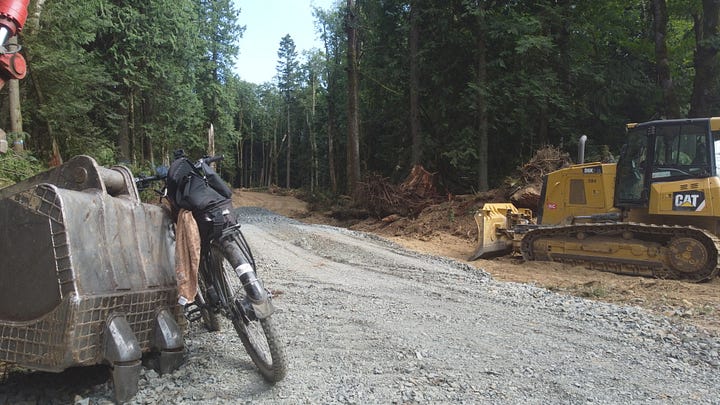
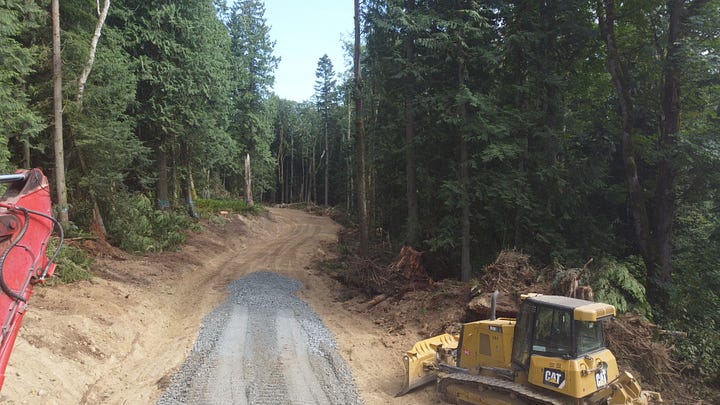
First : About this mountain
This mountain has been repeatedly logged, first with horses and steam donkey and railroad lines since pre 1900’s. My residence road, ‘Y’ road was a logging railroad line before community paved road.
Timber companies when I arrived here in the 1960’s were taking timber from the mountain, pulp to make toilet paper, they were burning the slash often with no replanting of trees. When I arrived in 1967 the forest on this part of the mountain, the Olsen Creek Valley, was naturally regenerated firs, cedar, hemlock with alder birch. It was the same aged forest where I made my home where in 1967 all the trees were 55 years old. In late 60’s and 70’s I hiked all over this naturally regenerating forest. I imagined then forest understory agriculture as a way to avoid clearcutting. Early 80’s I made this really naive video with Guy Kramer and Harry Lord. My thanks to Arnie for his closing statement. It was all about using secondary forest products as a way to to avoid clear cut logging. I had a lot yet to learn.
Me and this mountain
Forty five years ago I hiked through this younger stand of trees contemplating an alternative fate for this forest. I'm kind of connected to this place. I imagined then in 1975, today 2023 I would have a trail there up for me and my horse, collecting wildcrafted medicinal plants. I made a plan, wrote proposals, made a movie in the early 80's about product development. I still feel that special use of the forest production can enhance ecological recovery. I also feel that wildlife recovery should be a part of forest recovery, more about this later.
Click Here for a 4 minute 1991 video from Rich. It’s all about resource analysis and utilization, product and economic development touted as Forest Understory Agriculture.
The problem for me then, these naive thoughts of mine from the 70 and 80’s, I was pondering my own romantic view of a future, forest understory agriculture but I had no experience. For one thing I did not account for the local ecology and the angle of the sun up here 44 degrees North. Here the dominant Fir, Hemlock and Cedar trees continued to grow another hundred feet tall by 2023 putting the forest understory into deep shade, overtopping deciduous trees and dying shrubs, taking the water.
Around 2010 when I visited my friends in Sao Paulo State, at the Tropic Of Capricorn, 26 degrees South. In Brazil, people were growing coffee trees and gardens with tomatoes fruiting in similar places to here under the forest canopy where grass dosen’t grow. The sun was directly overhead there. The Tropic of Capricorn lies at south of the Equator marking the most southerly latitude at which the sun can appear directly overhead at noon. Here 44 degrees North we only enjoy this momentarily in spring.
The first trees cut for the new logging road
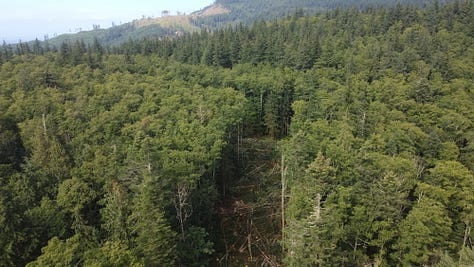
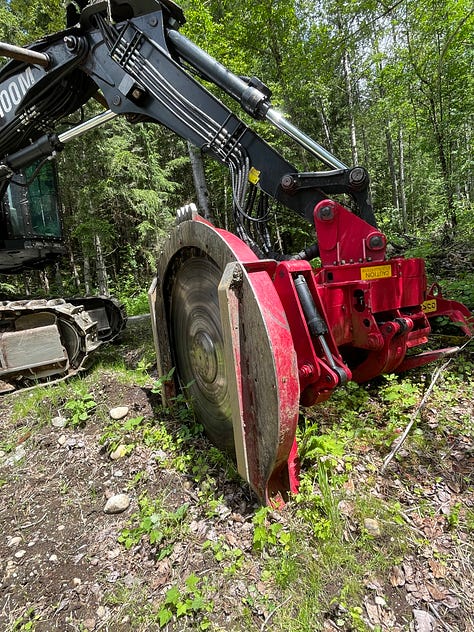
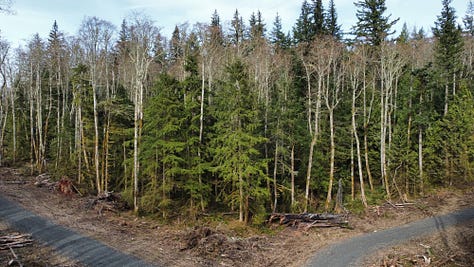
I retired in 2018 and rode every day thru this 100 year old forest. I realized this was going to happen and I wanted to write about this place.
Given my connection with this place, in 2021, it was emotional for me in a way to watch this forest be gone. The feeling that became fascination as the logging company came in and did their work. I had never observed this process of industrial logging from beginning to end. I began to meet and chat with foresters preparing the road for future truck use.
After operations started, First I first introduced myself and then only visited when operations were halted.
Today after the logging there is trail building underway. The logging road now is wildland access for people and their horses.
Questions abounded for me then that could be answered just by watching. Just how will this place be impacted by the logging and machines? The soils, that seasonal pond I found. Will the following winters reveal more damage or will recovery be rapid? What happens to the ferns and mosses and shrubs and the frogs that sang there before their communal catastrophe?
I have learned a lot and I have started to look at this mountainside with its mosaic of tree stands, differently.
I met an old logger up there, a retired gentleman who spent his career up here on this mountain. He drives there in his red truck and just like me just to spends some time in the old clear cut. We're chatted several times.. One time he said to me, 'This place should never be logged again'.
During the fall and winter before the logging began the Olsen Creek bridge was replaced. It was a great time to meet the DNR people. I’ll be writing a story about new bridge, the two prior bridges and their fates for Stewart Mountain Stories.
This Olsen Creek logging road, for 3 years prior I had been riding my electric bike up there for nature study and exercise. Both sides of the valley, it's a mosiac of recovering forests. Some natural recovery some replanted. One place, in 50 foot doug fir trees with open fern understory where 55 years ago that I grew a few pot plants among a christmas tree size forest.
Same place, no kidding it’s a humbling sensation to realize that the forest has grown around me, no, it’s a feeling of priviledge.




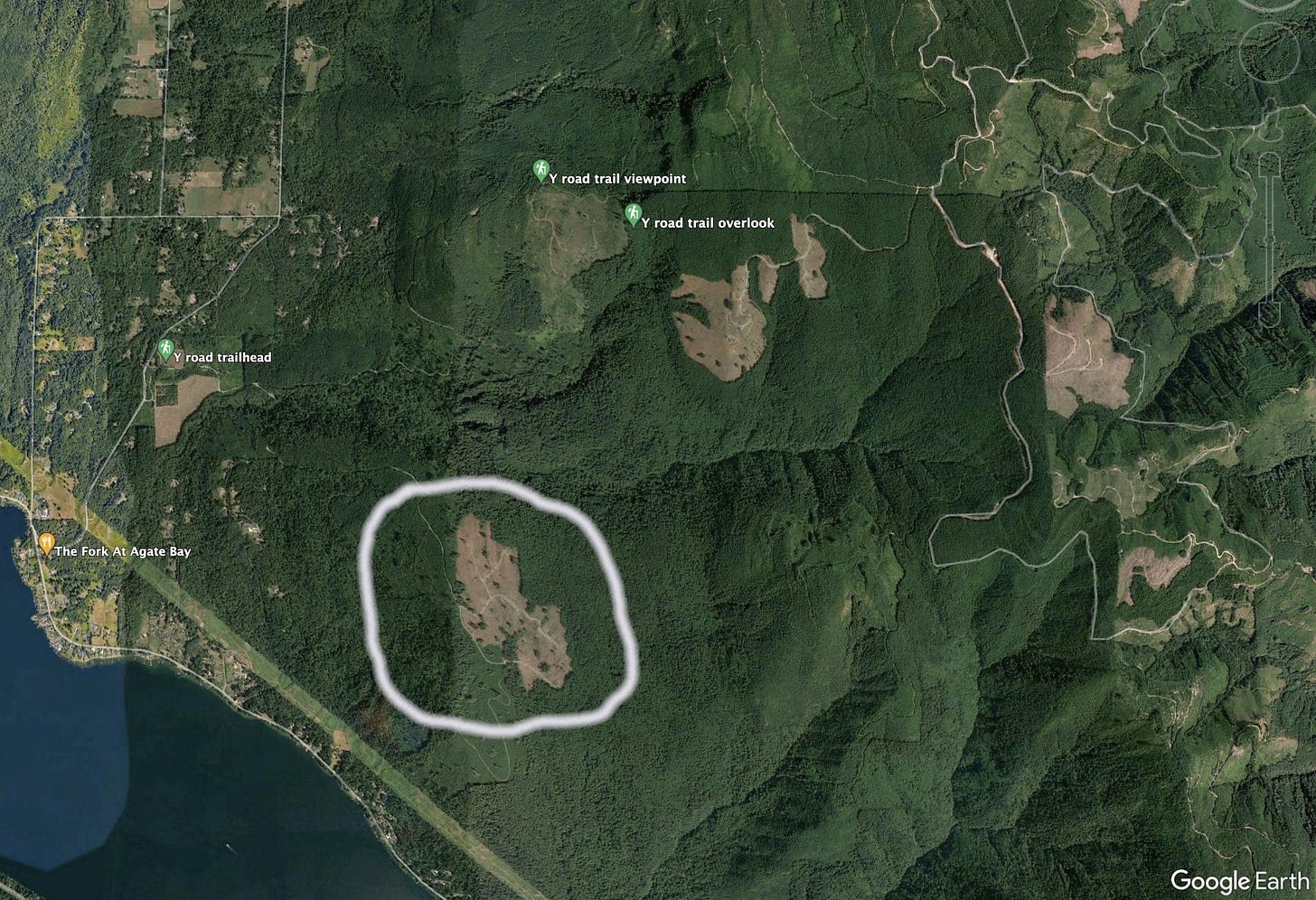
Rich, Thanks for writing this. Important for people to track history of places. I am still a promoter of forest understory agriculture. With different successional patterns over time. Nice to hear you are still riding bikes and observing forests. Love, for our old times together.